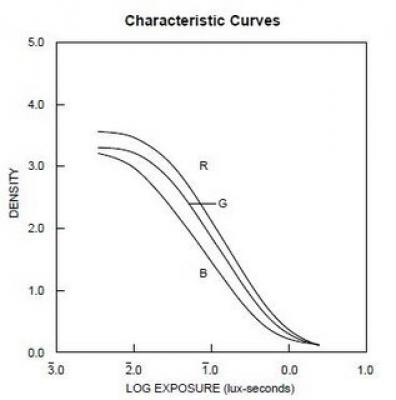Dynamic Range
 Now, a few words about the number one problem in movie scanning. It’s clearly evident in this plot. Well, maybe it’s not that clear. Let me explain.
Now, a few words about the number one problem in movie scanning. It’s clearly evident in this plot. Well, maybe it’s not that clear. Let me explain.
The plot shows the density on the processed film as a function of the exposure. These curves are the most important characteristic to be understood about any particular film, so they are called the “Characteristic Curves”. Density is the log of % of light blocked by the developed image, in this case, by the dye layers of the Kodachrome 40 movie film. Plotted against LogE, or log exposure – the amount of light striking the film when it is exposed in the camera.
Kodachrome is a reversal film, meaning that after it is developed, it is not a negative, as with “print” film, but the image looks just like the scene that was photographed, and you can view it with a projector directly, rather than making prints from the negative.
If the slope of the main part of those curves was -1, then a LogE change of exposure of 1 would result in a change in density of -1, and the image on the film would have the same dynamic range, or apparent contrast, as the scene.
But with most reversal film, the slope is steeper than that, meaning the contrast of the final image is greater than that of the scene. “Kodachrome, They give us those nice, bright colors…”
This is great for 8mm movies, which are usually viewed in a half darkened room with a cheap projector using a not-too-bright lamp and a lens with lots of flare. The high contrast of the image compensates for the bad viewing conditions.
But this feature is a big problem for scanning the film, as we are trying to do in a telecine machine. The dynamic range – the ratio of the lightest to the darkest parts of the scene – is quite a bit wider on the film than in the actual scene, meaning we really need a better digital camera to scan the film than we would need to capture the scene in real life. A density change of 1 is equivalent to about 3 photographic stops, or about 3 bits of digital data. As you can see in our plot, Kodachrome 40 is capable of a dynamic range of 3 to 3.5 in density, which means we really need a camera capable of at least 10 bits per pixel to record it all accurately.
Consumer quality cameras are typically limited to about 8 bits of dynamic range. The webcam I am using actually has a 10 bit A/D converter, but as with most tiny CCD imagers, the 2 least significant bits of data are mostly noise. We need bigger pixels and a good analog signal path to get 10 bits or better, and that means a lot more expensive camera.
There are a few things to do to make the most of the 8 bit data. A nicely diffuse light source, balancing the illuminant to match the CCD response, and minimizing flare and light leaks in the optics, and carefully adjusting exposure and gamma are all critical. As I said earlier, the most important rule is DON’T OVEREXPOSE. In the sample frames above, there are shadow areas that appear completely black, but if you examined the film under a microscope, you’d see lots of detail in those shadows – folds of fabric, leaves of trees, blades of grass – but it’s all gone black in my frames. Yet the frames look pretty nice, because the highlights are not clipped. Our eyes and/or brains are usually a lot more focused on the highlights, and when they are “blown out” or clipped, the image looks really bad. So we almost always expose for the highlights. Plus, in digital imaging, highlights that are just a bit overexposed are clipped quite abruptly to white, whereas the shadows smoothly disappear into the noisy blackness. Occasionally, there is something really important in those shadows – a face, for instance – and we might want to compromise the whole scene just to see that face. But most of the time, we want to preserve the highlights to make the film look great. Then it’s only if you compare the digital side by side with the film that you’ll see what’s missing.
So I can’t capture the true dynamic range of the film, but the webcam actually does a pretty good job. If you examine a film frame under a microscope, you can see that the digital capture does not have the same tonal range. On the other hand, the digital rendition looks great compared to the way we used to watch the movies with the old DeJUR projector, and it’s far, far better than the VHS tape Dad paid $100 for a few years ago. I wouldn’t use my webcam based machine for archiving priceless museum film, but it will certainly make my family happy.

This is fantastic, I have a lot of old 16mm feature films that don’t exist on DVD or VHS and have been looking for a way to affordably save them from obscurity.
Did you think about doing a multiple pass at different exposures and running a HDR pass to try and capture the full dynamic range of the film?
I’m thinking of getting an imaging source camera to capture with, not sure how I would go about syncing it though.
Comment by Peter — July 24, 2011 @ 1:36 am
I think HDR is probably the best solution. I would not do multiple passes, though, as the matching and registration of frames could be quite complicated. Some others are using LED sources and changing the illumination for two exposures at each frame time, since the LEDs can be switched very quickly.
Look at Fred Van DePutte’s site for syncing the imaging resource camera, and Frank Vine’s site for LED control ideas. These guys are the leaders in this work!
Comment by jimmymc — July 24, 2011 @ 5:47 am